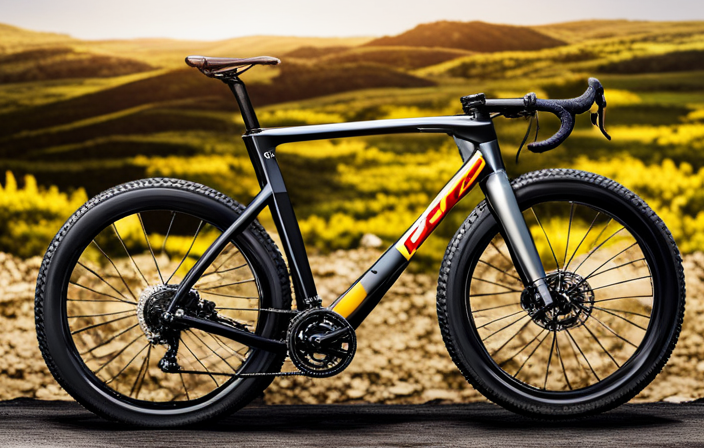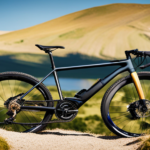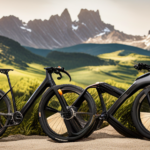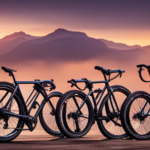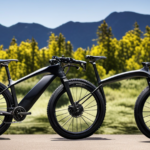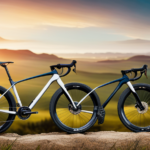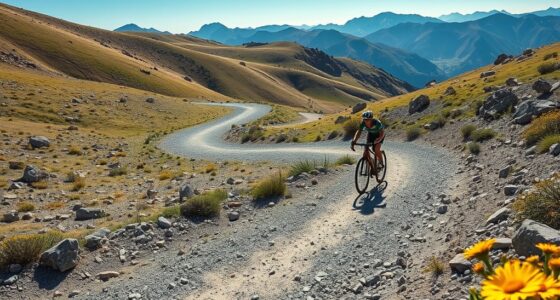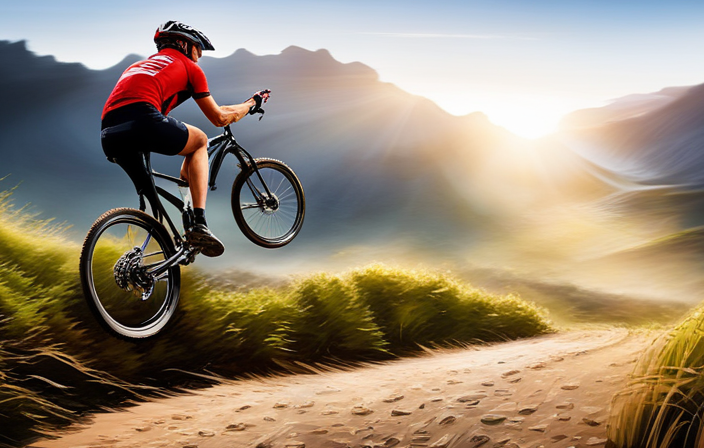What sets a gravel bike apart in the United Kingdom?
Well, get ready to embark on an exhilarating journey as we explore the ins and outs of this versatile two-wheeled wonder.
From its purpose-built design to its adaptability on various terrains, a gravel bike offers an exciting blend of road and mountain biking.
Join me as we uncover the benefits, safety considerations, training tips, and future trends that make gravel biking a thrilling adventure in the United Kingdom.
Key Takeaways
- Gravel bikes are versatile bikes designed for both pavement and off-road terrain, offering a balance between versatility and performance.
- Key features of a gravel bike include wider tires (35-45mm) for better traction, disc brakes for reliable stopping power, a relaxed geometry for better control and comfort, and multiple mounting points for racks and panniers.
- Gravel bikes are adaptable to different terrains, including smooth roads and rough gravel paths, thanks to their wide tires and disc brakes.
- Riding a gravel bike in the UK offers benefits such as less maintenance, specific accessories available, the ability to explore a wide variety of landscapes, and versatility for riders who switch between road cycling and off-road adventures.
The Definition and Purpose of a Gravel Bike
If you’re in the UK and looking for a versatile bike that can handle both pavement and off-road terrain, a gravel bike is exactly what you need. Gravel bikes are designed to offer the perfect balance between versatility and performance, making them ideal for riders who want to explore various terrains without compromising on speed or comfort.
One of the key advantages of owning a gravel bike is its ability to handle different types of surfaces. Whether you’re riding on smooth roads, rough trails, or even gravel paths, these bikes provide a stable and comfortable ride. They typically feature wider tires with more tread patterns, which offer better traction and control on loose or uneven surfaces.
When it comes to maintenance and repairs, gravel bikes are relatively easy to take care of. Regular cleaning after rides and occasional lubrication are usually sufficient to keep them in good condition. Additionally, most components on gravel bikes are similar to those found on road bikes, making them easily replaceable if needed.
Now let’s move onto the key features and components of a gravel bike without any further delay.
Key Features and Components of a Gravel Bike
To get the best out of your gravel riding experience, you’ll want to know about the essential features and components found on these versatile machines. A gravel bike is designed to handle a variety of terrains, from rough gravel roads to smooth pavement and everything in between. Its key features and components are specifically tailored to provide versatility benefits and ensure a comfortable ride.
One important feature of a gravel bike is its wider tires, typically around 35-45mm. These wider tires offer more traction and stability on loose surfaces, allowing you to confidently tackle gravel paths or dirt trails. Additionally, most gravel bikes come equipped with disc brakes for reliable stopping power in all weather conditions.
Another crucial component is the frame construction. Gravel bikes often have a more relaxed geometry compared to road bikes, providing a more upright riding position for better control and comfort during long rides. The frames are also built with durability in mind, as they need to withstand the rigors of off-road adventures.
In terms of maintenance, it’s important to keep your gravel bike clean after each ride, especially if you’ve been riding through mud or dirt. Regularly inspecting the chain for wear and ensuring proper lubrication will also help prolong its lifespan.
With their versatility and adaptability for different terrains, gravel bikes open up a world of possibilities for exploration and adventure.
Versatility and Adaptability for Different Terrains
When riding a gravel bike, you’ll appreciate its versatility and adaptability for tackling various terrains. Gravel bikes are designed to handle a wide range of surfaces, from smooth roads to rough gravel paths. Here are three key features that make gravel bikes so versatile:
-
Wide Tires: Gravel bikes typically come with wider tires than road bikes, usually around 35mm to 45mm. These wider tires provide better traction and stability on loose surfaces like gravel or dirt.
-
Disc Brakes: Most gravel bikes are equipped with disc brakes, which offer reliable stopping power in all weather conditions. This is especially important when riding off-road or in wet conditions where rim brakes may struggle to perform.
-
Mounting points: Gravel bikes often have multiple mounting points for racks and panniers, making them ideal for bikepacking adventures. You can easily carry all your gear and supplies for long-distance rides or multi-day trips.
Whether you’re looking to tackle challenging terrain or participate in gravel bike races, a gravel bike’s versatility will help you conquer any obstacle along the way.
Now let’s explore the benefits of riding a gravel bike in the UK without delay.
Benefits of Riding a Gravel Bike in the UK
Get ready to experience the numerous advantages of riding a gravel bike in the UK. Not only are gravel bikes incredibly versatile and adaptable for different terrains, but they also offer a range of benefits that make them ideal for riding in the UK.
One advantage is that gravel bikes require less maintenance compared to other types of bikes. Thanks to their sturdy construction and durable components, they can handle rough terrain without needing frequent repairs or adjustments. Additionally, there are many accessories available specifically designed for gravel biking in the UK. These include fenders to protect against muddy conditions, bikepacking bags for long-distance adventures, and wider tires for added stability on loose surfaces.
Riding a gravel bike in the UK allows you to explore a wide variety of landscapes and environments. From winding country lanes to rugged off-road trails, these bikes can handle it all. They provide a smooth ride on paved roads while still offering enough traction and control on unpaved surfaces. This versatility makes them perfect for riders who want to switch between road cycling and off-road adventures without needing multiple bikes.
Now let’s delve into how gravel bikes compare to road bikes and mountain bikes…
Comparison to Road Bikes and Mountain Bikes
If you’re considering different types of bikes, it’s important to compare gravel bikes to road bikes and mountain bikes.
When comparing a road bike vs gravel bike, there are a few key differences to consider. Road bikes are designed for speed and efficiency on paved roads. They have skinny tires, lightweight frames, and drop handlebars that allow the rider to maintain an aerodynamic position. Gravel bikes, on the other hand, are built for versatility. They have wider tires with more aggressive tread patterns, which provide better traction on off-road surfaces like gravel and dirt trails. Gravel bikes also typically have more relaxed geometry compared to road bikes, providing a more comfortable riding position.
When it comes to mountain bike features, gravel bikes share some similarities but also have their own distinct characteristics. Both types of bikes have wider tires compared to road bikes for improved stability and grip off-road. However, mountain bikes generally have even wider tires with more pronounced knobs for maximum traction in rough terrain. Mountain bikes also feature suspension systems that absorb bumps and shocks from uneven surfaces.
In conclusion, comparing gravel bikes to road and mountain bikes reveals their unique attributes suited for different terrains and riding preferences.
Now let’s move on to choosing the right gravel bike for your needs…
Choosing the Right Gravel Bike for Your Needs
To choose the right gravel bike for your needs, consider factors such as your riding style, terrain preferences, and desired level of comfort.
The first thing to think about is bike fit. A properly fitted gravel bike will ensure that you are comfortable and efficient while riding. Take into account your body measurements, flexibility, and riding position when selecting the frame size and adjusting the saddle height.
Next, think about the type of terrain you plan on riding. Gravel bikes come in various designs suited for different conditions. If you’ll be tackling rougher terrains with more technical features, opt for a bike with wider tires, lower bottom bracket height, and a longer wheelbase for stability. On the other hand, if you plan on covering long distances on smoother roads or tracks, a gravel bike with narrower tires and a more aggressive geometry may be more suitable.
Lastly, consider how much maintenance you are willing to do. Gravel bikes require regular cleaning due to the dirt and debris they encounter. Look for models with easy-to-clean components like sealed bearings or internal cable routing.
In conclusion, choosing the right gravel bike involves considering factors such as bike fit and terrain preference while also thinking about how much maintenance you are willing to perform. This will ensure that you find a bike that suits your needs perfectly.
Now let’s move on to some tips for maintaining and caring for your gravel bike without compromising its performance.
Tips for Maintaining and Caring for Your Gravel Bike
For optimal performance and longevity, it’s important to regularly maintain and care for your gravel bike. By following a few simple maintaining techniques and cleaning procedures, you can keep your bike in top shape for all your off-road adventures.
One key aspect of maintenance is keeping your drivetrain clean. The chain, cassette, and derailleur should be regularly cleaned with a degreaser and a brush. This will prevent the build-up of dirt and grime that can cause shifting issues. Additionally, it’s essential to keep your tires properly inflated and check them for any signs of wear or damage.
Cleaning the frame is also crucial to maintain its appearance and prevent rusting. Use a mild soap or bicycle-specific cleaner along with a soft cloth to remove any dirt or mud from the frame. Pay special attention to hard-to-reach areas such as the bottom bracket shell and seat tube junction.
Lastly, don’t forget about the suspension fork if your gravel bike has one. Regularly inspect it for any leaks or damage, and follow the manufacturer’s guidelines on maintenance.
By implementing these maintaining techniques and cleaning procedures, you’ll ensure that your gravel bike stays in excellent condition throughout its lifespan.
Now let’s explore some popular gravel bike brands and models in the UK.
Popular Gravel Bike Brands and Models in the UK
When looking for a reliable off-road adventure companion, you’ll find a wide variety of popular gravel bike brands and models available in the UK. Here are three popular gravel bike brands in the UK that offer models for different budgets:
-
Specialized: Specialized is known for its high-quality bikes and has a range of gravel bike models to suit various price points. Their Diverge series is particularly popular, offering both entry-level options and more advanced models with features like carbon frames and hydraulic disc brakes.
-
Canyon: Canyon is a German brand that has gained popularity in recent years. They offer a range of gravel bikes, including the Grail series, which has innovative features such as their unique double-decker handlebar design for added comfort and control.
-
Ribble: Ribble is a British brand that offers great value for money without compromising on quality. They have an extensive range of gravel bikes, including the CGR series, which offers versatile options suitable for both on and off-road riding.
These are just a few examples of the popular gravel bike brands available in the UK. Now let’s move on to discussing recommended accessories and gear for gravel bike riders…
Transition into next section: Now that we’ve explored some popular gravel bike brands in the UK, let’s take a look at recommended accessories and gear for gravel bike riders.
Recommended Accessories and Gear for Gravel Bike Riders
Now that you’ve chosen your ideal gravel bike from the popular brands and models available in the UK, it’s time to make sure you have all the necessary accessories and gear for a successful ride.
As a gravel bike rider myself, I understand the importance of being well-prepared on every adventure.
First and foremost, investing in safety equipment such as a helmet, reflective clothing, and lights is crucial for visibility on the road. Additionally, having puncture repair kits and basic maintenance tools will save you from unexpected mishaps during your ride. To stay fueled and hydrated, consider carrying nutrition and hydration products specifically designed for endurance sports.
If you’re planning longer rides or bikepacking trips, essential gear includes navigation tools like GPS devices or smartphone apps, as well as storage solutions such as saddlebags or frame packs. Lastly, don’t forget about proper clothing to suit different weather conditions.
By equipping yourself with these recommended accessories and gear, you’ll be ready to explore the best gravel bike routes in the UK with confidence.
So let’s dive into our next section where we’ll uncover some of these incredible routes that await us!
Exploring the Best Gravel Bike Routes in the UK
Let’s delve into some of the amazing routes in the UK that are perfect for exploring on your trusty gravel bike! Whether you’re a seasoned rider or just starting out, these routes offer a mix of challenging terrain and breathtaking scenery. One of the best things about riding a gravel bike is the versatility it provides, allowing you to venture off-road and explore places that other bikes simply can’t reach.
When it comes to choosing a gravel bike brand, there are several top contenders in the market. Some of the best gravel bike brands include Specialized, Cannondale, Trek, and Giant. These brands offer reliable bikes that can handle all types of terrain and provide comfort during long rides.
As for the actual routes, there are plenty of options to choose from in the UK. Some popular gravel bikepacking routes include The South Downs Way in England, which stretches across 100 miles of stunning countryside and offers both challenging climbs and fast descents. Another great option is The Highland 550 in Scotland, a demanding route that covers over 550 miles through remote wilderness areas.
Exploring these routes not only allows you to enjoy nature at its finest but also gives you an opportunity to connect with fellow gravel bike enthusiasts. Joining gravel bike clubs and communities is a fantastic way to share experiences, learn new skills, and make lasting friendships on two wheels.
So let’s dive into this exciting world by discovering some incredible UK routes!
Joining Gravel Bike Clubs and Communities
If you’re looking to connect with other enthusiasts and build lasting friendships, joining gravel bike clubs and communities is a fantastic way to do so. These clubs offer a supportive and inclusive environment where you can share your passion for gravel biking with like-minded individuals. Not only will you get the chance to meet new people who share your interests, but you’ll also have access to a wealth of knowledge and experience that can help improve your skills on the bike.
When joining gravel bike clubs, one of the biggest benefits is being able to find local gravel bike routes. Members often organize group rides or share information about their favorite routes, making it easier for you to discover new trails in your area. Whether you’re a beginner or an experienced rider, these routes cater to all skill levels, ensuring that everyone can find something suitable.
By participating in these club rides, you’ll not only have an opportunity to explore new trails but also learn from more experienced riders. They can provide valuable insights into technique, gear selection, and maintenance tips that will help enhance your overall riding experience.
Once you’ve joined a gravel bike club and found some local routes that suit your preferences, it’s time to focus on improving your training and fitness levels.
Training and Fitness Tips for Gravel Bike Riding
Improving your training and fitness levels is essential for maximizing your enjoyment of gravel biking. Gravel bike training involves a combination of endurance, strength, and skill-building exercises. To help you get started, here are some fitness tips to keep in mind:
-
Endurance Training: Focus on building up your cardiovascular fitness by incorporating long rides into your training schedule. Gradually increase the duration and intensity of these rides to improve your stamina.
-
Strength Training: Strengthening your lower body muscles will help you tackle challenging terrains with ease. Include exercises like squats, lunges, and deadlifts in your routine to target key muscle groups used in gravel biking.
-
Core Stability: A strong core is crucial for maintaining balance and stability while riding on uneven surfaces. Incorporate exercises like planks, Russian twists, and bicycle crunches to strengthen your core muscles.
-
Skill-Building Exercises: Practice handling skills such as cornering, descending, and navigating rough terrain to enhance your overall riding ability.
Remember to listen to your body and gradually progress with each workout session. By following these gravel bike training tips, you’ll be well-prepared for the challenges that lie ahead.
Now let’s move on to the next section about safety considerations and precautions for gravel bike riders…
Safety Considerations and Precautions for Gravel Bike Riders
Ensure your safety while riding on gravel by taking necessary precautions and considering important factors. One of the most crucial aspects for gravel bike riders is having a proper bike fit. A well-fitted bike can greatly enhance your riding experience and reduce the risk of injuries. It’s important to ensure that the frame size, saddle height, and handlebar position are all adjusted correctly for your body proportions. This will not only improve your comfort but also optimize power transfer and handling on uneven terrain.
In addition to a proper bike fit, it is essential to have the right safety gear when riding on gravel. Helmet is an absolute must-have item for all gravel enthusiasts as it protects your head in case of an accident or fall. Gloves provide better grip and protect your hands from blisters, while knee pads offer extra protection during challenging descents or unexpected obstacles.
As you transition into the subsequent section about ‘gravel bike events and competitions in the UK’, remember that participating in these events can be a great way to challenge yourself and showcase your skills as a gravel rider. However, it’s important to keep in mind that safety should always be your top priority while enjoying this exciting sport.
Gravel Bike Events and Competitions in the UK
Get ready to experience the thrill of gravel bike events and competitions in the UK! These events are a fantastic way to test your skills, push your limits, and connect with fellow gravel bike enthusiasts. Whether you’re a seasoned rider or just starting out, there’s something for everyone in these exciting gatherings.
-
Adrenaline-pumping races: Feel the rush as you compete against other riders in thrilling gravel bike races. From short sprints to long-distance challenges, these events will get your heart racing and your adrenaline pumping.
-
Breathtaking routes: Explore the stunning landscapes of the UK on specially designed gravel bike routes. Ride through picturesque countryside, tackle challenging terrains, and marvel at breathtaking views along the way.
-
Community spirit: Immerse yourself in a vibrant community of like-minded individuals who share your passion for gravel biking. Connect with fellow riders, exchange tips and tricks, and forge lifelong friendships that extend beyond the racecourse.
As gravel biking continues to gain popularity in the UK, these events are only set to grow bigger and better. The future trends and developments in the gravel bike industry promise even more exhilarating competitions, innovative equipment advancements, and unforgettable experiences on two wheels. So lace up those cycling shoes and get ready for an incredible journey into the world of gravel biking!
Future Trends and Developments in the Gravel Bike Industry
The future of the gravel biking industry promises exciting advancements in equipment and unforgettable experiences on two wheels. As more and more people discover the joy of riding off-road, manufacturers are constantly developing new technologies to enhance the gravel bike experience.
One of the future innovations we can expect to see is improved suspension systems. Gravel bikes are known for their versatility, allowing riders to tackle a variety of terrains. However, rough trails can be challenging without proper suspension. Manufacturers are working on developing lightweight yet effective suspension systems that will provide a smoother ride without compromising the bike’s agile nature.
Another area where we can expect to see developments is in sustainability initiatives. With an increasing focus on environmental conservation, many gravel bike manufacturers are incorporating eco-friendly materials into their products. From recycled frame materials to sustainable packaging, companies are taking steps towards reducing their carbon footprint.
Additionally, there may be advancements in electronic shifting technology for gravel bikes. While this technology is already common in road cycling, it has not been widely adopted in the gravel biking world. However, as electronic shifting becomes more affordable and reliable, we may see an increase in its use within the gravel bike industry.
Overall, the future of the gravel biking industry looks promising with exciting innovations and a focus on sustainability initiatives. Whether you’re a seasoned rider or just getting started, these advancements will undoubtedly enhance your off-road adventures.
Frequently Asked Questions
Are gravel bikes suitable for beginners?
Gravel bikes are a great option for beginners who want more versatility than a traditional road bike.
When comparing gravel bikes to mountain bikes, it really depends on personal preference and the type of terrain you’ll be riding on.
Gravel bikes offer a smoother ride on paved roads while still being capable off-road.
To choose the right size gravel bike, consider your height, inseam length, and reach measurements.
It’s important to get properly fitted to ensure comfort and optimal performance.
Can I use a gravel bike for commuting?
Yes, you can definitely use a gravel bike for commuting. Gravel bikes have several advantages that make them suitable for everyday use.
They are designed to handle various terrains, from smooth roads to rough gravel paths, providing a comfortable ride. The wider tires offer stability and control, while the disc brakes ensure reliable stopping power.
However, it’s important to consider the cons as well, such as added weight and slower speeds compared to road bikes.
What type of tires should I use for different terrains?
When it comes to choosing the right gravel bike tires for different terrains, there are a few factors to consider.
First and foremost, tire pressure is crucial. Lower tire pressure helps with grip on loose surfaces like gravel or dirt, while higher pressure is better for smoother roads.
Additionally, the tread pattern plays a role in determining traction and handling. It’s important to find a balance that suits your riding style and the specific terrain you’ll be encountering.
How often should I maintain and service my gravel bike?
I recommend following a regular maintenance schedule for your gravel bike to ensure optimal performance and longevity.
Generally, it’s advised to have your bike serviced at least once a year or every 1,000 miles, whichever comes first.
This includes checking and adjusting components such as brakes, gears, and bearings.
Common gravel bike issues may include chain wear, brake pad replacement, and tire pressure adjustments for different terrains.
Regular maintenance will help identify and address these issues promptly.
Is it necessary to wear specific safety gear while riding a gravel bike?
Oh, absolutely not! Who needs safety gear when riding a gravel bike? Just throw caution to the wind and hope for the best, right?
Well, actually, that couldn’t be further from the truth. Safety should always be a top priority when riding any type of bike, including gravel bikes.
Proper bike fit is crucial for stability and control on rough terrain. Additionally, choosing the right helmet designed specifically for gravel biking can provide essential protection in case of falls or accidents.
So please, don’t skimp on safety gear!
Conclusion
In conclusion, a gravel bike in the UK is not just any ordinary bicycle. It’s a versatile and adaptable machine designed to conquer diverse terrains.
With its key features and components, it provides riders with an exhilarating experience like no other. From smooth roads to rugged trails, a gravel bike handles it all with finesse.
So, whether you’re seeking adventure or fitness, hop on your gravel bike and let the wind whip through your hair as you explore the great outdoors.
Get ready for a wild ride!
